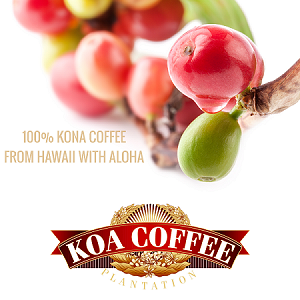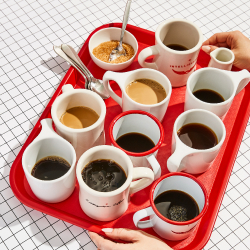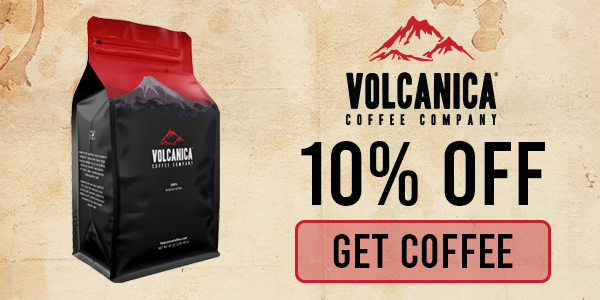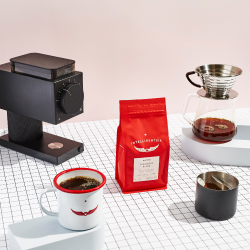Coffee—a daily ritual, a morning jolt, a comforting brew, and the world’s most beloved beverage. While the global coffee scene is diverse, two key players reign supreme: Arabica and Robusta. Today, we turn the spotlight on the latter, the hardy variety which often stands in the shadows of its more popular cousin. So, what is Robusta coffee?
Also known as Coffea Robusta, it is a species of coffee that thrives in challenging climates and offers a bold, distinctive taste. Despite its less glamorous reputation compared to Arabica, this coffee has carved its own niche in the global coffee industry, with numerous Robusta coffee brands making significant waves.
In this comprehensive guide, we take an in-depth exploration of this delectable beverage, tracing its journey from the coffee fields to your coffee cup. We will delve into the characteristics that set Robusta apart, the intricacies of its cultivation and processing, and the distinct flavor profile it delivers. Whether you’re a curious coffee enthusiast, a seasoned barista, or someone just beginning their coffee adventure, this guide aims to enrich your understanding and appreciation of this dynamic brew. So, buckle up and get ready for a fascinating expedition into the robust world of this coffee.
What is Robusta Coffee? – Key Takeaway
- Robusta coffee, known as Coffea Robusta, is a resilient coffee variant known for its higher caffeine content, stronger flavor, and distinctive aroma compared to its Arabica cousin.
- The cultivation and processing of Robusta coffee play critical roles in defining its unique flavor profile. Grown primarily in Africa and parts of Asia, the beans go through various processing techniques, including washing and drying, and careful roasting to develop the distinct robusta taste.
- Robusta has a unique taste profile, often characterized by its strong, nutty, and chocolatey flavors. Its sensory characteristics are enhanced by specific grinding and brewing methods, providing a diverse experience for coffee lovers.
- Robusta coffee has several health impacts. Rich in antioxidants, this coffee can offer several health benefits when consumed responsibly. However, due to its high caffeine content, overconsumption can lead to potential side effects.
- Robusta Coffee holds a significant position in the global coffee industry. Despite various sustainability and ethical challenges, robusta continues to be an economically important crop. The industry sees a promising future with the increasing focus on sustainable and fair-trade practices, along with a growth in consumption trends worldwide.
The Origin and Cultivation of Robusta Coffee
To appreciate the complexity of this beverage brew, it’s essential to explore its roots and understand the journey it undertakes from being a seed to becoming the invigorating drink in your cup.
Understanding Robusta: The Coffee Species
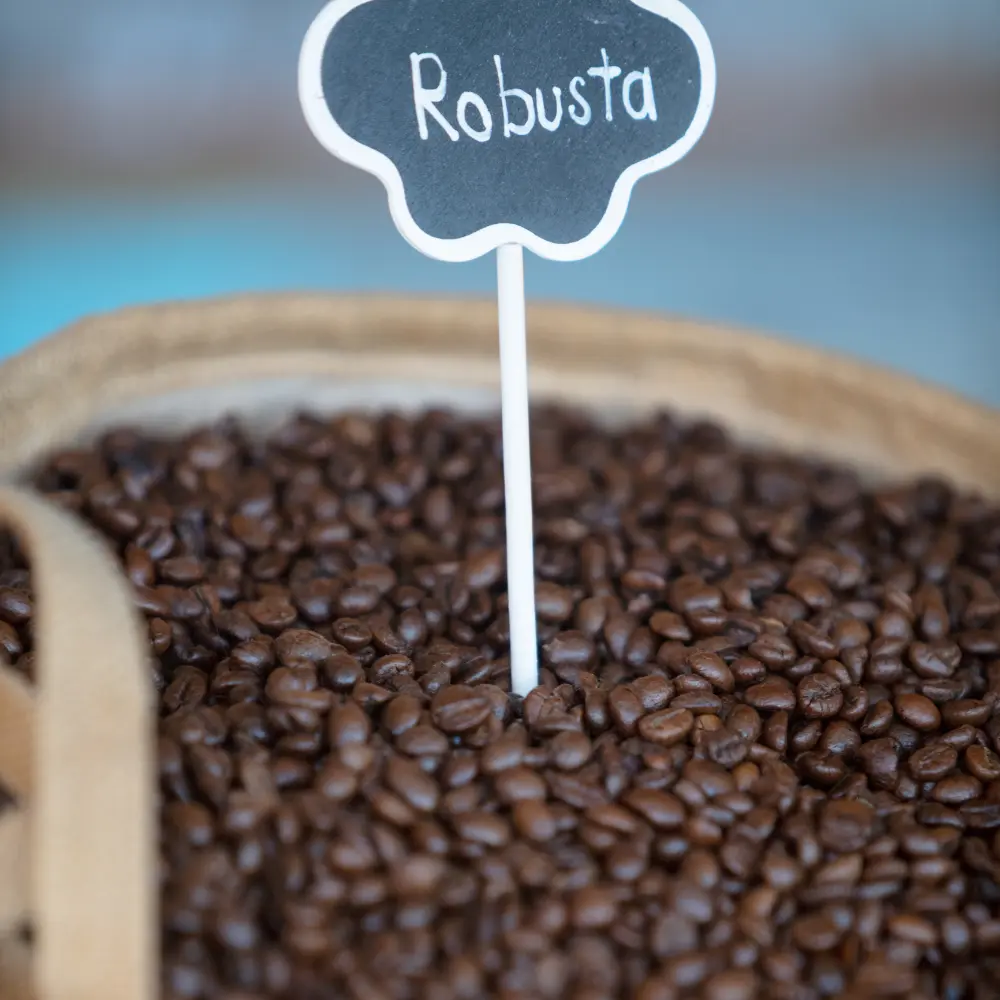
Robusta, also named Coffea Robusta, is one of the two most popular species of coffee plants, the other being Arabica. Originating from central and western sub-Saharan Africa, it is known for its resilience and ability to withstand harsh conditions, a trait from which it gets its ‘robust’ name. Robusta coffee plants are capable of growing at lower altitudes and in hotter climates, which makes them resistant to pests and diseases. (1)
The beans of robusta are smaller and rounder compared to Arabica, and they have higher caffeine content. This results in a strong, full-bodied coffee with a distinctive, earthy flavor. While some coffee enthusiasts criticize robusta for its less subtle flavor profile compared to Arabica, it is this very uniqueness that makes it essential in espresso blends, providing the characteristic crema.
Geography and Climate: Where Does Robusta Thrive?

This coffee flourishes in a wide range of tropical climates around the globe, particularly regions close to the equator. The optimal growing conditions for robusta include:
- Altitude: Unlike its Arabica counterpart, which requires high altitudes, robusta coffee thrives at lower elevations, typically between 200 and 800 meters above sea level.
- Temperature: Robusta prefers a hotter climate, ideally with temperatures between 24-30°C (75-86°F).
- Rainfall: A consistent, year-round rainfall of about 2000-3000 mm is ideal.
These growing conditions are predominantly found in Africa, Asia, and South America. Major robusta-producing countries include Vietnam, which is the world’s largest producer, followed by Brazil, Indonesia, and Uganda.
Cultivation Practices: Sowing to Harvesting Robusta Coffee

The cultivation of this coffee starts with planting the seeds in large beds in shaded nurseries. When the seedlings become sturdy, usually after six to eight weeks, they are transferred to individual pots and carefully tended until they are ready for planting in the field. This happens when they reach a height of about 30 cm, and it usually occurs during the rainy season to ensure the seedlings have sufficient water to establish themselves.
The Coffea Robusta plants begin to bear fruit in their third year. The fruits, called cherries, are typically handpicked when they are bright, glossy red—a sign of ripeness. After picking, the cherries undergo processing, which can be either the wet (washed) method or the dry (natural) method, to extract the beans. Following this, the beans are dried, sorted, and bagged for export or further roasting.
Understanding this coffee’s species, its preferred growing conditions, and the detailed cultivation process offers a new appreciation for the complexity of the journey that brings this dynamic brew to your cup.
From Bean to Brew: The Processing of Robusta Coffee
The journey of this beverage doesn’t end on the plantation; it’s merely the beginning. Once the cherries are picked, they undergo a series of processes to transform into the coffee we know and love. From the immediate post-harvest processing techniques to roasting and brewing, each step significantly impacts the final cup’s quality and taste.
Post-harvest Processing Techniques

After harvesting, Coffea Robusta cherries need to be processed promptly to prevent spoilage. Two main methods are commonly employed:
- Dry Method: This is the oldest and simplest method of coffee processing, where harvested cherries are spread out in the sun to dry for several weeks. The dried fruit husk is then removed to reveal the green coffee bean.
- Wet Method: Also known as the washed method, it involves removing the pulp from the coffee cherry soon after harvesting and then fermenting the remaining matter to detach the final skin layer. The beans are then washed and dried.
Each method imparts distinct characteristics to the coffee, with the dry method typically producing a sweet, full-bodied coffee, and the wet method resulting in a clean, bright flavor.
The Role of Roasting in Defining Coffee Flavor

Roasting is the heart of the coffee-making process, where green coffee beans transform into the aromatic brown beans we are familiar with. It’s during roasting that the beans’ unique flavor compounds develop, resulting in a distinctive coffee aroma and taste.
The roasting process involves heating the coffee beans at high temperatures until the moisture inside them evaporates, causing the beans to expand and change color. These coffee beans are generally roasted between 180-230°C (356-446°F). The roasting duration and temperature significantly influence the flavor profile of the coffee, ranging from light, medium, to dark coffee roasts.
Grinding and Brewing Methods for Robusta Coffee
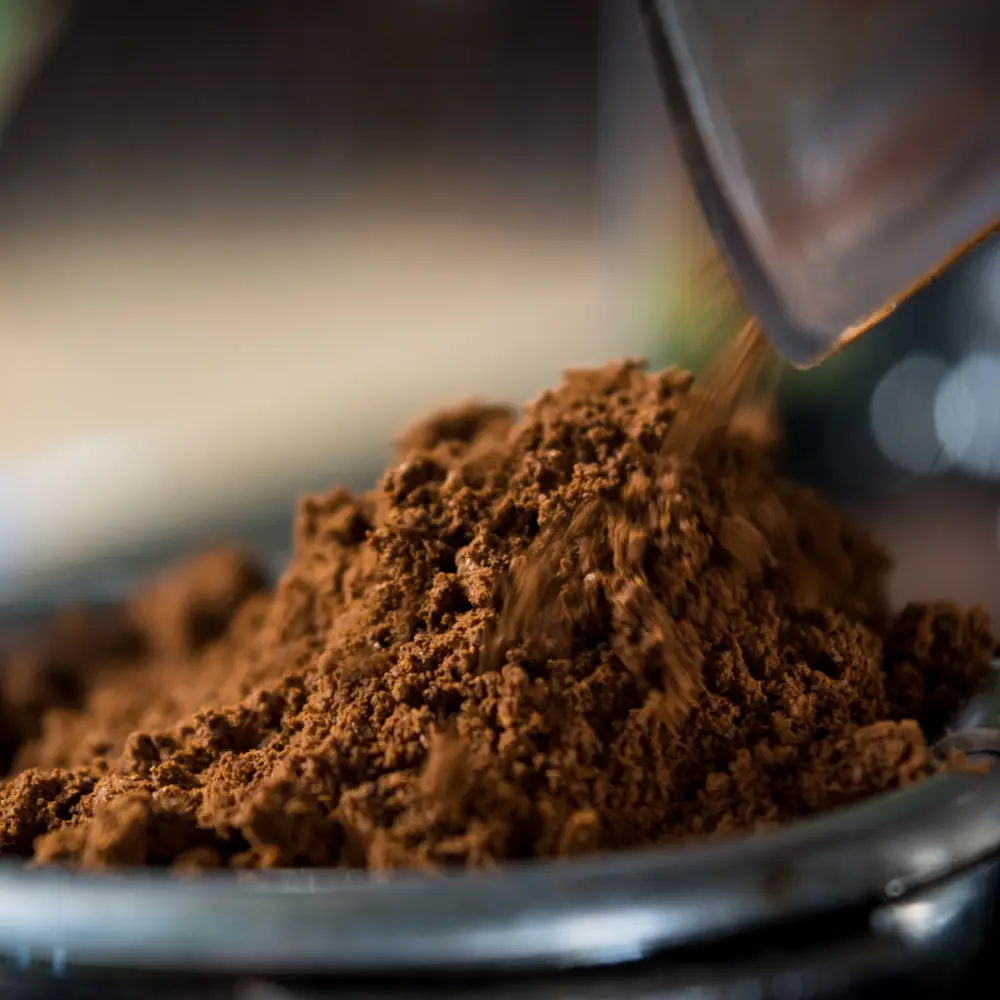
Grinding is the next crucial step in coffee preparation. It’s essential to get the coffee grind size right to extract the optimal flavor from the beans. Burr coffee grinders are often recommended for their consistency and control over the grind size.
For this beverage, the grind size depends largely on the brewing method you prefer:
- Extra Fine Grind: Great for Turkish coffee/ibrik coffee
- Fine Grind: Ideal for espresso machines
- Medium Grind: Suitable for drip coffee makers
- Coarse Grind: Perfect for French press or cold brew
When it comes to brewing, robusta coffee is versatile. It can be brewed using various methods, such as espresso, drip, French press, or cold brew, each offering a unique way to experience the robust, full-bodied flavor of robusta.
As you can see, every step in the processing of this coffee—from post-harvest techniques, through roasting, to grinding and brewing—contributes to its unique flavor profile. Understanding this can help you appreciate your cup of joe even more.
Decoding the Taste: Flavor Profiles of Robusta Coffee

A dive into the flavor profile of this coffee is an exploration of bold, unique, and captivating tastes that have captivated coffee lovers worldwide. Let’s decode and experience the sensory characteristics of this beverage, understand the science behind coffee tasting, and engage in the eternal comparison of robusta and Arabica coffee.
Sensory Characteristics of Robusta Coffee
Robusta coffee, known for its strong, bold flavor, has a taste profile that is both distinct and captivating. Here are a few key sensory elements that define the robusta experience:
- Flavor Intensity: This beverage is celebrated for its robust intensity. The flavor is often described as bold and strong, cutting through milk and sugar. It is ideal for those who prefer their coffee powerful and impactful.
- High Bitterness: Due to the high caffeine content—almost double that of Arabica—robusta coffee carries a more pronounced bitterness. This bitterness can be an acquired taste for some, but it adds a distinct kick to the brew that many coffee lovers enjoy.
- Lower Acidity: In contrast to Arabica coffee, which is known for its bright acidity, robusta has lower acidity levels. This characteristic lends robusta a smoother, less tart flavor profile.
- Body: Robusta offers a full-bodied coffee experience. Its brew is typically thicker, lending a substantial, creamy feel in the mouth—particularly noticeable in espressos.
- Coffee Aroma: Robusta is also recognized for its intense aroma. The smell of this coffee drink is often described as earthy, with a hint of grain and nuts. It’s a heady mix that draws you into the robusta experience before even taking the first sip.
The Science Behind Coffee Tasting
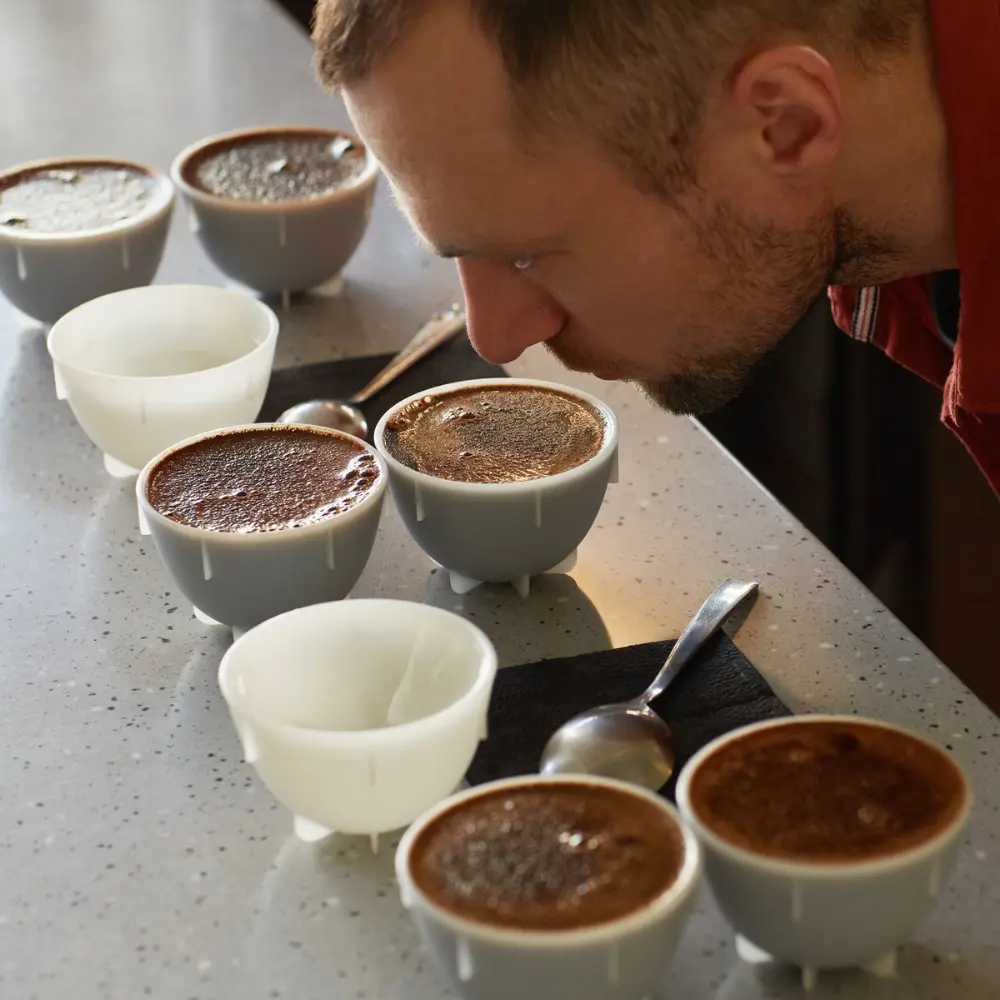
Coffee tasting, or ‘coffee cupping,’ is both an art and a science. It allows professionals and enthusiasts alike to appreciate the nuanced flavors of coffee, including robusta. Here’s how it works:
- Fragrance and Aroma: The coffee-tasting process begins with evaluating the fragrance of the dry coffee grounds and the aroma of the freshly brewed cup. This phase can reveal many initial flavor clues.
- Flavor Assessment: The main event of cupping is the actual tasting. The aim is to identify the different flavors present in the coffee. Is it sweet or bitter? Can you detect notes of chocolate, fruit, or nuts?
- Body and Texture: Tasting also involves feeling the coffee in your mouth. Is it light and watery or thick and creamy? This mouthfeel is described as the ‘body’ of the coffee.
- Acidity: Acidity refers to the tangy, bright notes in coffee, contributing to its overall flavor profile. It should not be mistaken for the actual pH of the coffee.
- Aftertaste: Finally, cupping involves savoring the coffee’s aftertaste or finish. This is the flavor that lingers in your mouth after swallowing the coffee.
Understanding this process can immensely enhance your appreciation of robusta’s unique flavor characteristics.
Comparing Robusta and Arabica: A Flavor Battle
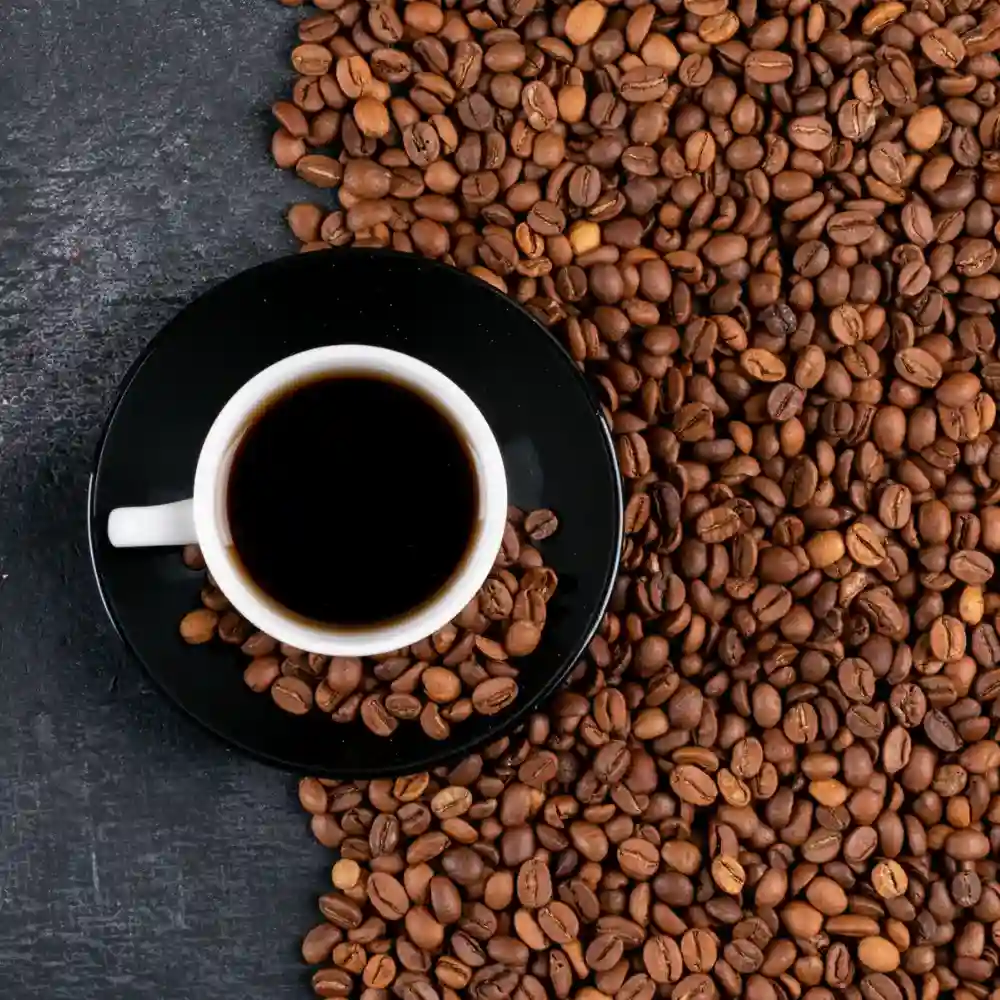
Robusta and Arabica are the two heavyweight champions of the coffee world, each offering distinct flavors and characteristics. Here’s how they stack up:
- Taste: Arabica is generally sweeter and softer, with overtones of sugar, fruit, and berries. Robusta, on the other hand, is robust and full-bodied, with a distinctive earthy flavor and a pronounced coffee bitterness.
- Caffeine Content: As previously mentioned, robusta beans have nearly double the caffeine content compared to Arabica. While this attribute can contribute to the perceived bitterness of robusta coffee, it also renders it an excellent option for individuals in search of a more powerful caffeine boost.
- Acidity: Arabica typically boasts high acidity, making its taste more vibrant and bright, while robusta’s low acidity contributes to its smoother, less tart profile.
- Price: Arabica is generally more expensive than robusta due to its delicate growing conditions and the perceived complexity of its flavor.
In summary, the Arabica vs Robusta coffee debate comes down to personal preference. Each type of coffee has its own loyal fan base and a unique place in the world of coffee.
Robusta Rendezvous: Adventures in Coffee Pairing
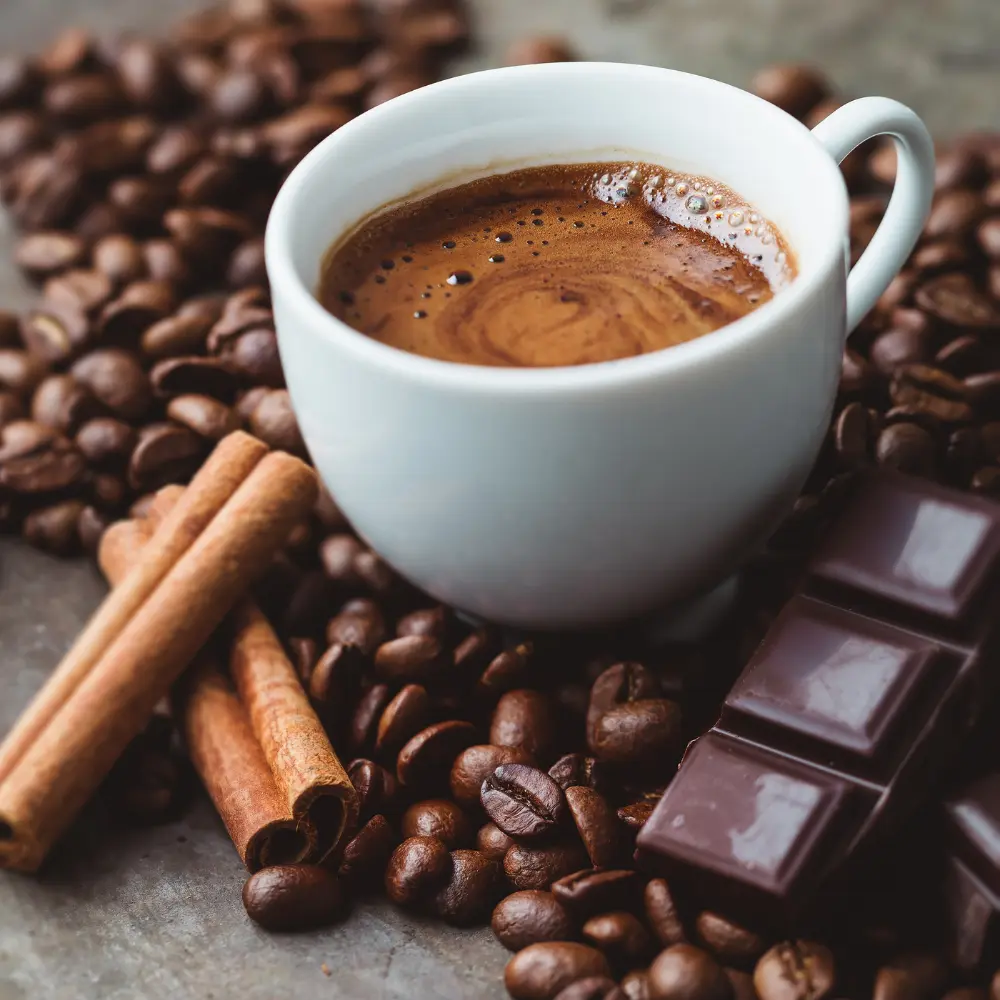
Finding the right food to pair with your coffee can elevate the coffee-drinking experience to a new level. Here are some food pairing ideas that harmonize well with robusta’s robust flavor profile:
- Dark Chocolate: The bitter notes of dark chocolate resonate perfectly with the bold, earthy flavors of robusta. The pairing is a dance of bitterness and sweetness that brings out the best in both.
- Nutty Desserts: Nut-based desserts like almond biscotti or walnut brownies complement the nutty undertones of this beverage, creating a harmonious blend of flavors.
- Creamy Cheeses: The rich, creamy textures of cheeses like brie or camembert provide a beautiful contrast to robusta’s strong, bitter notes. The fat content in the cheese helps mellow the bitterness, allowing the coffee’s other flavors to shine.
- Hearty Breakfast: A full English breakfast with sausages, beans, and toast can stand up to robusta’s strong, bold flavor. The coffee’s robustness cuts through the rich, fatty flavors, creating a balanced, satisfying meal.
Finding the perfect food to pair with your coffee is an adventure. So, embark on a journey of flavor exploration and discover how robusta coffee can be a perfect companion to your meals.
Comparing Robusta with Liberica, and Excelsa Coffee Beans

Diving deep into the world of coffee, we often find ourselves orbiting around Arabica and Robusta. However, the family of Coffea has some hidden gems like Liberica and Excelsa waiting to be discovered. Let’s set sail on a flavor adventure and compare these three unique coffee breeds.
Robusta
The unsung hero in the realm of coffee, Robusta, is the second most consumed coffee species globally. It captivates coffee lovers with its robust, full-bodied flavor and high caffeine punch. With a low acidity profile, it provides a smooth finish that keeps coffee aficionados coming back for more. Robusta’s distinct characteristics place it at the heart of many espresso blends and instant coffee powders.
Liberica
Stepping off the beaten path, we meet the Liberica coffee beans. Native to Liberia in West Africa, this species caters to a small niche in the global coffee market. The Liberica coffee plant is a giant, capable of towering up to 66 feet, and bears large, irregularly shaped beans. On the palate, Liberica unveils a complex flavor symphony. Expect a full-bodied cup marked with a smoky, woody essence, harmoniously intertwined with floral and fruity undertones. Liberica’s unique taste, coupled with its rarity, garners it a place in the coffee connoisseur’s collection.
Excelsa
Venturing further into the coffee wilderness, we encounter the Excelsa species. Often mistaken for Liberica due to taxonomic reshuffling, Excelsa now stands recognized as a unique species. Flourishing in the fertile lands of Southeast Asia, Excelsa contributes a mere 2% to the world’s coffee yield, making it a rare find. Excelsa coffee is acclaimed for its tart, fruity, and occasionally wine-like flavors. Its light body and complex flavor profile make it a captivating choice for those seeking a twist in their everyday coffee experience.
Exploring the distinctive traits of Robusta, Liberica, and Excelsa coffee offers us a broader perspective on the richness of coffee diversity and its dynamic taste palette. As we navigate this fascinating flavor voyage, each cup of coffee serves as a delightful reminder of the vast world of coffee that waits to be tasted.
The Health Impacts of Robusta Coffee

Beyond the pleasure of its bold flavor and rich aroma, this coffee drink also presents a myriad of potential health benefits. However, as with anything, moderation is key. This section will delve into the nutritional value of robusta coffee, explore its health benefits, and address potential side effects while giving insights on how to enjoy coffee responsibly.
Nutritional Value of Robusta Coffee

Robusta coffee, derived from the Coffea robusta plant, is a low-calorie beverage loaded with beneficial compounds that contribute to its health properties. Here’s a snapshot of what a typical cup of unsweetened coffee contains:
- Calories: Virtually calorie-free, making it an excellent choice for those watching their caloric intake.
- Caffeine: Contains roughly 265 mg of caffeine per 8-ounce cup. Caffeine can improve cognitive function, mood, and physical performance. (2)
- Antioxidants: This coffee is a significant source of antioxidants, which fight harmful free radicals in the body.
- Essential Nutrients: Contains small amounts of vitamins and minerals, including Vitamins B2, B3, and B5, Manganese, and Potassium.
Understanding the nutritional value of your cup of joe can help you make informed dietary decisions and appreciate your brew beyond its stimulating effect.
Exploring the Health Benefits of Robusta Coffee

Robusta coffee is more than just a wake-me-up beverage. It carries a variety of potential health benefits:
- Improved Cognitive Function: The caffeine in this delectable coffee can enhance brain function, improving mood, reaction time, memory, and general cognitive function.
- Protection Against Diseases: Thanks to its high content of antioxidants, regular consumption of this drink can help protect against several diseases, including certain types of cancer, Alzheimer’s, and Parkinson’s disease.
- Physical Performance Boost: Caffeine can enhance physical performance by increasing adrenaline levels, making it a great pre-workout drink.
- Liver Health: Some studies have linked regular coffee consumption with lower risks of diseases like liver cirrhosis and liver cancer.
Remember, while coffee can contribute to a healthy lifestyle, it should not replace a balanced diet and regular exercise.
Potential Side Effects and How to Enjoy Coffee Responsibly

Despite its benefits, it’s crucial to enjoy this coffee responsibly, as excessive intake may lead to several side effects:
- Sleep Disruption: Caffeine can interfere with your sleep, especially if consumed close to bedtime.
- Digestive Issues: High amounts of caffeine can lead to digestive issues such as acid reflux and stomach ulcers.
- Dependence: Regular consumption of caffeine can lead to dependence, resulting in withdrawal symptoms like headaches, irritability, and fatigue when you skip your regular cup.
- Bone Health: Excessive intake of coffee can interfere with calcium absorption, affecting bone health.
Here are some tips for enjoying coffee responsibly:
- Limit Your Intake: Aim to keep your coffee intake to a moderate level. For most people, this means no more than 3-4 cups per day.
- Be Cautious with Additives: Adding sugar, cream, or flavored syrups can turn your healthy cup of robusta into a calorie-laden beverage.
- Pay Attention to Timing: Avoid drinking coffee late in the day to ensure it doesn’t interfere with your sleep.
Understanding both the potential benefits and side effects of this coffee can help you enjoy your favorite beverage in a way that aligns with your health and well-being goals. Remember, while a cup of robusta can offer a delightful boost, moderation is key to reaping its benefits without the drawbacks.
Top Picks: Outstanding Robusta Coffee Brands
When it comes to this coffee, not all brands are created equal. As coffee lovers, it’s imperative to understand what sets apart the average from the exceptional. This guide illuminates some of the best robusta coffee brands that excel in taste, aroma, and overall coffee experience.
Biohazard Ground Coffee – The Morning Thunderstorm in a Cup

Biohazard Ground Coffee promises more than just your average caffeine fix. Imagine being jolted awake by an electrifying 928mg of caffeine per 80oz serving. This potent brew is capable of resurrecting you from the deepest sleep and propelling you through the most demanding of days. Be it an exhausting business meeting, an early-morning lecture, or an all-night study session, Biohazard Ground Coffee is your reliable partner.
- A Caffeine Powerhouse: With an astonishing 928mg of caffeine, this coffee offers a natural energy surge without any hint of bitterness.
- Uncompromising Quality: Single-origin, top-tier Robusta beans are used to give you a delightful and potent flavor profile.
- Perfect for: conquering a demanding workweek, managing energetic offspring, amplifying workout performances, or attaining unparalleled gaming focus.
- Bonus Feature: The 5lb bag is perfect for workplaces, offices, or even dining establishments.
Dalat Highlands Robusta – The Silk Road of Flavors

Delve into the luxurious symphony of flavors with Dalat Highlands Robusta Whole Bean Coffee. Known for its chocolatey richness, it’s a treat when enjoyed on its own or when blended with Arabica to enrich the coffee crema.
- Chocolate Delight: An espresso made from Dalat Highlands Robusta offers a delightful chocolate symphony.
- Exceptional Flavor: The highland-grown Robusta from the Dalat Province offers a dark, opulent flavor with low acidity.
- Sustainability Focus: Packaged in Biotre 100% biodegradable coffee bags, each purchase supports environmental consciousness.
| Preview | Product | |
|---|---|---|

|
Dalat Highlands Peaberry Robusta Whole Bean Coffee, 1lb | See on Amazon |
Death Wish Coffee Dark Roast – The Dark Knight of Morning Brews
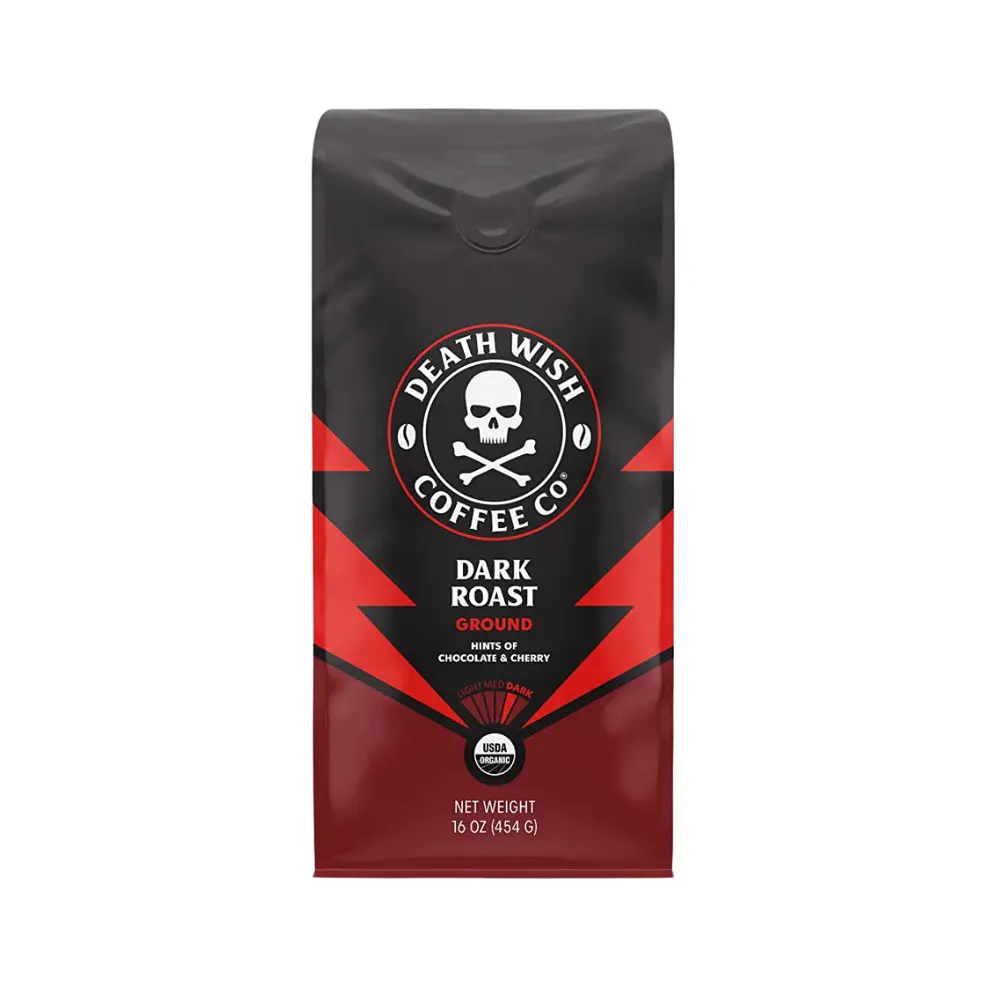
Begin your day with Death Wish Coffee Dark Roast Grounds, a coffee that doesn’t shy away from a strong, bold flavor. This blend strikes a perfect balance between the robustness of Robusta and the nuanced flavors of Arabica.
- Energizing Essence: A robust and invigorating cup that’s perfect to kickstart your morning.
- Quality Focus: The blend offers intense, bold flavors and is crafted using premium Arabica and Robusta beans.
- Smooth and Strong: The slow batch roasting process renders a low-acid brew with a smooth texture.
- Satisfaction Guaranteed: The brand offers a risk-free experience, with a promise of a refund if you’re not fully satisfied.
Each of these brands offers a unique take on this beverage, highlighting the richness, diversity, and robustness that define this beloved coffee variety. From the hardcore caffeine kick of Biohazard to the dark, rich flavor of Death Wish Coffee, there’s a brew for every taste.
Robusta Coffee in the Global Coffee Industry
This coffee drink plays a significant role in the global coffee industry, contributing to its economic landscape, wrestling with sustainability and ethical challenges, and shaping future consumption trends. As coffee enthusiasts, it’s essential to understand these dimensions to appreciate the journey of robusta from farm to cup.
Economic Importance of Robusta Coffee
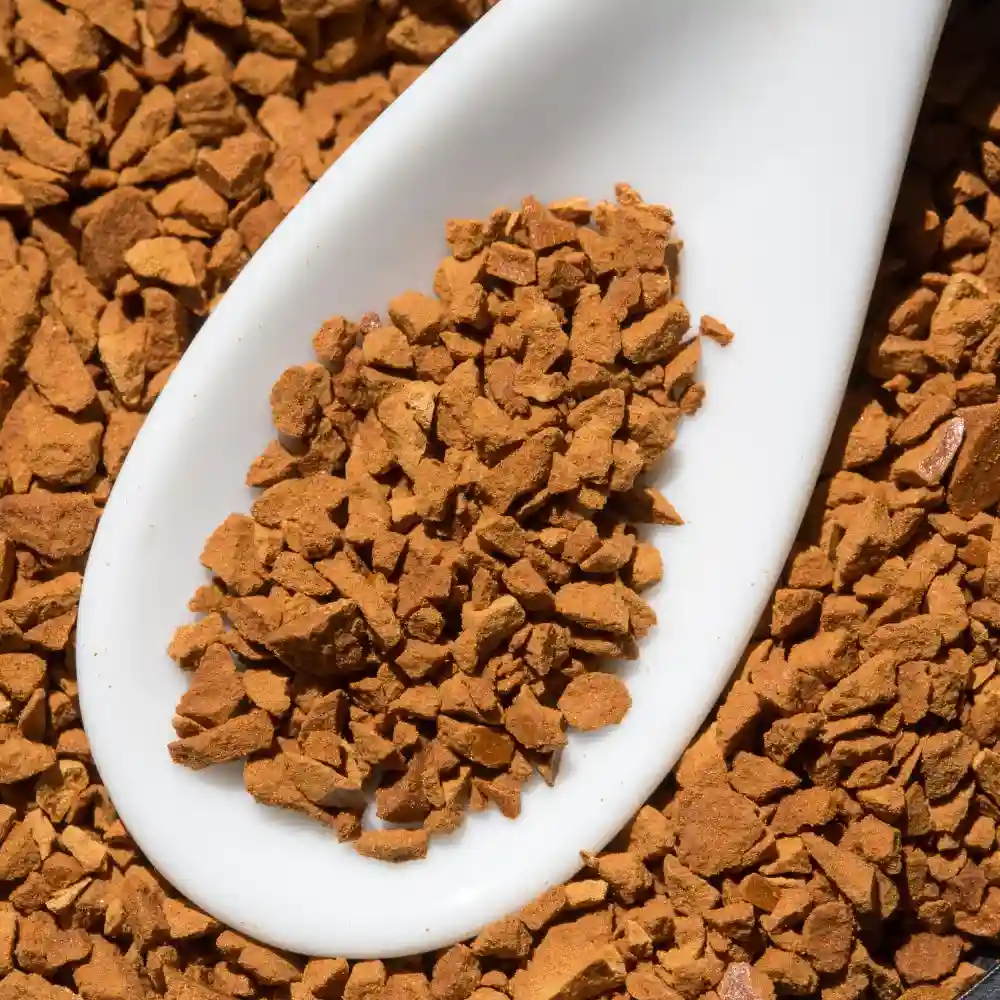
Robusta coffee, the less glamorous cousin to Arabica, plays a critical role in the global economy. Here’s how:
- Supplying Instant Coffee Market: This coffee’s strong flavor and high caffeine content make it the preferred choice for instant coffee and espresso blends. It represents between 40% and 45% of the global coffee production of the world’s coffee production, a testament to its economic importance.
- Source of Livelihood: The robusta plant, which is more resistant to pests and diseases than Arabica, thrives in various climates and terrains. It provides a vital source of income for farmers in countries such as Vietnam, the second-largest coffee producer globally, where robusta constitutes a significant portion of their coffee exports.
- Resilience Against Climate Change: Given the increasing challenges of climate change, the hardiness of this coffee plant offers a potential safeguard for coffee producers and economies reliant on coffee farming.
Sustainability and Ethical Issues in Robusta Coffee Production
However, the production of this coffee isn’t without its challenges. Sustainability and ethical practices are significant concerns in the industry.
- Environmental Impact: Coffee farming, if not managed sustainably, can lead to deforestation and loss of biodiversity. Additionally, the extensive use of chemicals can pollute local water supplies and harm the ecosystem.
- Fair Trade: Unfortunately, many coffee farmers, including those growing robusta, are not adequately compensated for their hard work. This has led to an increasing demand for fair-trade coffee, which ensures farmers receive a fair price for their produce.
- Labor Issues: Coffee production often involves long hours of physical labor, and in some regions, it’s associated with poor working conditions and even child labor.
Addressing these sustainability and ethical issues is crucial to ensuring the long-term viability of this coffee production and the well-being of those who rely on it for their livelihoods.
Future Trends in Robusta Coffee Consumption
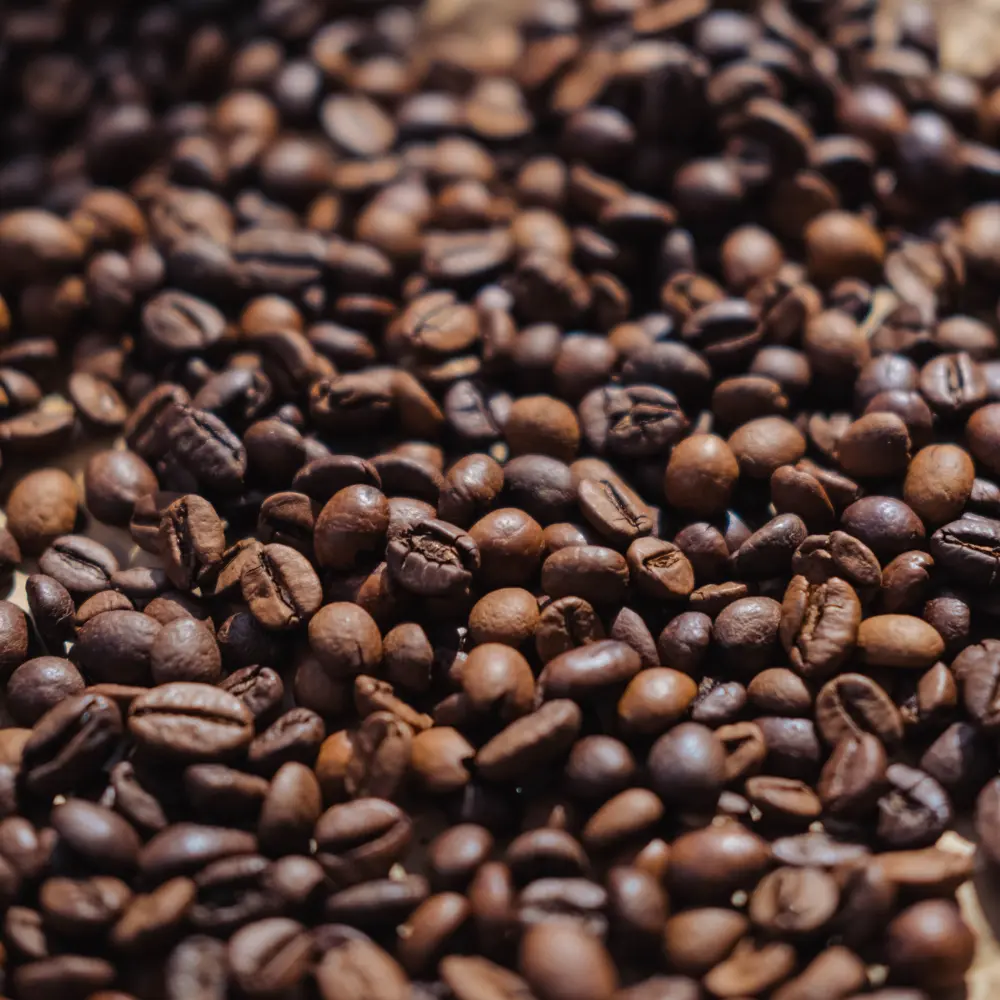
Looking toward the future, several trends may shape robusta coffee consumption:
- Increasing Demand for High-Quality Robusta: As consumers become more knowledgeable about coffee, the demand for high-quality Robusta beans is growing. We might see more single-origin Robusta offerings and an increase in Robusta blends in specialty coffee shops.
- Sustainable Coffee Practices: As awareness of sustainability issues in coffee production grows, consumers are more likely to seek out sustainably-produced and fair-trade coffee.
- Health and Wellness: Given the potential health benefits of this beverage, and the increasing consumer interest in functional foods, this coffee may gain popularity as a healthy beverage choice.
Understanding the broader context of this coffee in the global industry, from economic importance to sustainability challenges and future trends, can deepen our appreciation for this dynamic brew and inspire us to make choices that support sustainable and ethical coffee consumption.
Conclusion
In conclusion, robusta coffee, also known as Coffea Robusta, presents a dynamic brew, defined by its distinctive strong flavor, higher caffeine content, and resilience during cultivation. As we’ve journeyed from its historical roots and cultivation practices to the nuanced stages of processing and brewing, it’s evident that this delectable coffee holds a significant and unique position in the global coffee industry.
The taste profile of this beverage, although often contrasted with the mild and fruity notes of its Arabica cousin, offers a robust, nutty, and chocolatey depth of flavors that are truly its own. These flavor profiles are well-explored by the best robusta coffee brands, which showcase the breadth and depth of this coffee variant.
Moreover, our exploration revealed not only the economic significance of this crop but also the sustainability and ethical challenges that the industry faces. Indeed, the world of this coffee drink is as complex as it is captivating, filled with opportunities for taste discovery, industry growth, and cultivation innovation.
So, the next time you’re asked “what is robusta coffee?” you can not only answer the question but also delve into the intriguing intricacies of this dynamic brew. From the bean to the cup, every stage of the robusta journey adds to the unique character of this globally loved coffee type. Whether you’re a seasoned coffee connoisseur or a curious beginner, this beverage offers an experience worth exploring.
FAQ
How is robusta coffee processed?
This coffee is processed through methods like washing and sun drying, followed by roasting which brings out its distinct flavors.
What are the health benefits of robusta coffee?
This drink, rich in antioxidants, can boost mental alertness, improve physical performance, and may contribute to heart health.
How does the flavor profile of robusta coffee differ from other varieties?
This coffee boasts a unique flavor profile characterized by strong, nutty, and chocolatey notes, distinct from the milder flavors of Arabica or the floral tones of Liberica and Excelsa.
What is the economic significance of robusta coffee in the global coffee industry?
This beverage holds a significant position in the global coffee industry due to its resilience in cultivation, lower production costs, and its widespread use in instant coffee and espresso blends.

